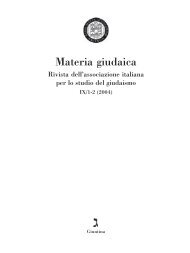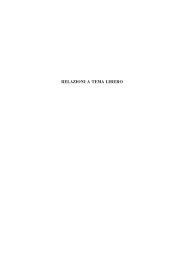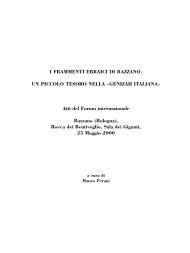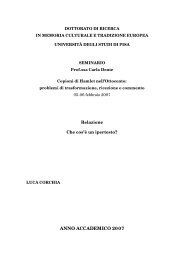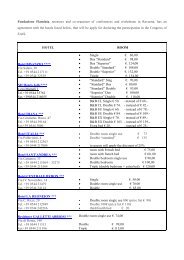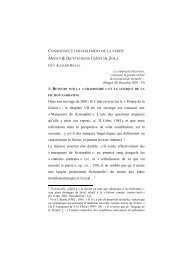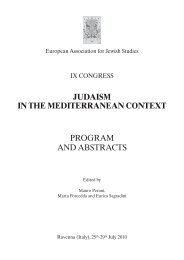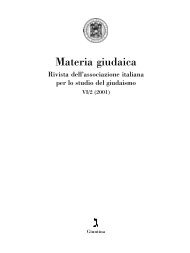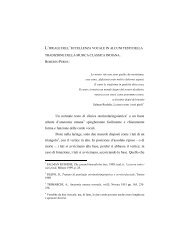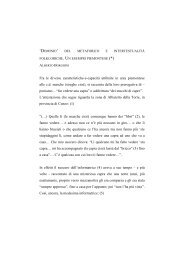161 Abraham Gross GERONA: A SEPHARDIC CRADLE OF ...
161 Abraham Gross GERONA: A SEPHARDIC CRADLE OF ...
161 Abraham Gross GERONA: A SEPHARDIC CRADLE OF ...
Create successful ePaper yourself
Turn your PDF publications into a flip-book with our unique Google optimized e-Paper software.
<strong>Abraham</strong> <strong>Gross</strong><br />
Solomon ben Adret’s. Nissim achieved fame as the<br />
head of the yeshivah in Barcelona, and among his<br />
disciples we find Isaac ben Sheshet Perfet, Hasdai<br />
Crescas, and Joseph Haviva.<br />
His anti-philosophical attitude – though<br />
without adopting any other spiritual alternative<br />
such as Qabbalah, contrary to most of the antiphilosophers<br />
in the 12 th -13 th centuries – is evident<br />
in his celebrated book of sermons known as<br />
Derashot ha-RaN (Rabbi Nissim).<br />
***<br />
How significant and long-lasting was the<br />
«Golden Age» of Gerona as a vibrant and creative<br />
religious and intellectual center on its own<br />
history and on the history of the Sefaradim? As<br />
to Nahmanides, let us quote a short excerpt from<br />
a recent evaluation of his centrality for Jewish<br />
intellectual history:<br />
«It would seem to me that we may say that he<br />
actually helped crystallize majors areas of study;<br />
by this I mean that his own works in these fields<br />
were pivotal contributions, intrinsically important<br />
and repercussive, as well as formative and directive.<br />
They provided substrata and molds for further<br />
activity» 14 .<br />
Nahmanides halakhic decisions apparently<br />
became binding in Catalunia, as we read in Isaac<br />
ben Sheshet Perfet’s responsum in the end of the<br />
14 th century:<br />
«In all the regions of Catalunia they rely on him<br />
as if it was Moses from the mouth of God [ke-Moweh<br />
mi-pi ha-Wekinah ]» 15 .<br />
The centrality of two of the above mentioned<br />
Geronese scholars in the Sephardic curriculum<br />
of talmudic studies in the 15 th century –<br />
including that of Castile – is documented. Isaac<br />
Qanpanton, the father of the Sefardi pilpul, instructs<br />
how one should analyze Nahmanidean<br />
super-commentaries on the Talmud. Nahmanides<br />
and Nissim Gerondi are mentioned together in<br />
an interesting autobiographical note by Judah<br />
Khalax, a Castilian rabbi who fled his homeland<br />
a few years before the expulsion of the Jews from<br />
Spain:<br />
«[...] and I came to Granada and stayed there<br />
for five years [...] and after the first year I did not<br />
agree to teach them super-commentaries [on the<br />
Pentateuch] but only the Talmud and Alfasi with<br />
the super-commentary of Rabenu Nissim [...] afterwards<br />
I came to Malaga and stayed for four years,<br />
and there too I taught only Talmud with the supercommentaries<br />
by Nahmanides. After that I arrived<br />
at Hunein and I taught my students there a small<br />
part of the week Rashi [on the Pentateuch] and the<br />
rest of the time I spent with them studying Talmud<br />
with Nahmanides [i.e. Nahmanides’ super-commentary]»<br />
16 .<br />
While it is beyond the scope of this paper<br />
to evaluate the ideas contained in the<br />
thought of Nissim Gerondi and how current<br />
they were in the 15 th century. I will remark only<br />
that it was significant in the writings of important<br />
figures such as R. Joseph Hayyun and of<br />
his student, Isaac Abravanel, and merits a<br />
separate study.<br />
Indeed to sum up the significance of<br />
Gerona in the broadest manner, I would use the<br />
following recent evaluation. It is the closing sentence<br />
of Y.T. Assis recent book on the «Golden<br />
Age of Aragonese Jewry», with which he attempts<br />
to capture the importance of the relatively<br />
small Jewish community of the Crown of<br />
Aragon:<br />
«Their literary production remains, to the present<br />
day, one of the richest contributions to Jewish culture<br />
and civilization» 17 .<br />
Come to think of it, this precise wording<br />
would be perfectly suitable as the final sentence<br />
14 I. TWERSKY, Introduction, in Rabbi Moses<br />
Nah manides (Ramban): Explorations in His<br />
Religious and Literary Virtuosity, p. 3.<br />
15 We’elot u-Tewuvot ha-RiBaSh (Isaac ben<br />
Sheshet Perfet), Jerusalem 1968, no. 415.<br />
16 Mewiah Ilmim, Jerusalem 1986, p. 10.<br />
17 Y.T. ASSIS, The Golden Age of Aragonese<br />
Jewry: Community and Society in the<br />
Crown of Aragon, 1213-1327, London 1997,<br />
p. 334.<br />
164



